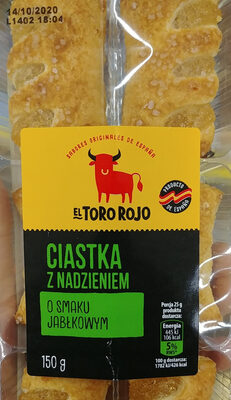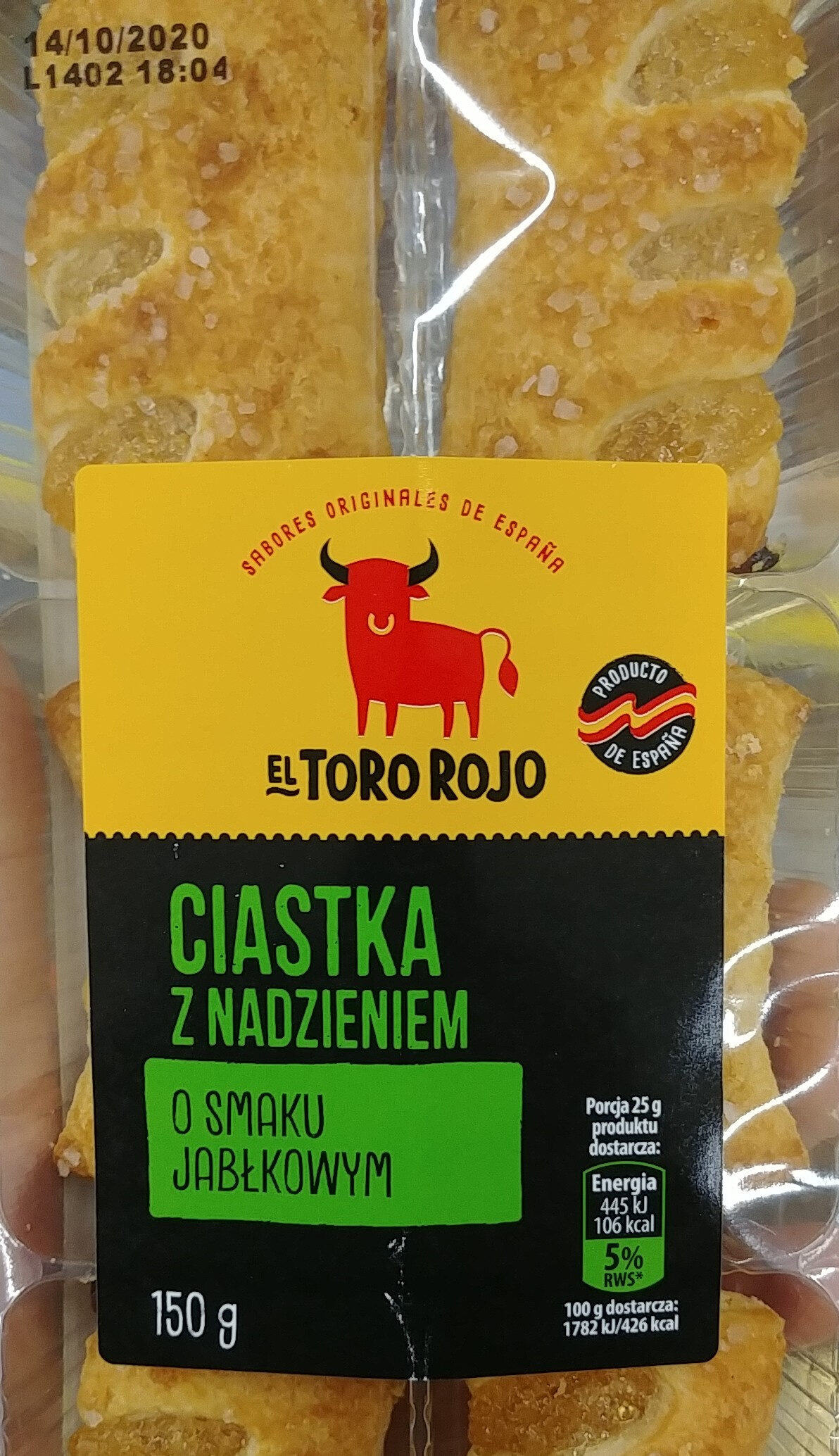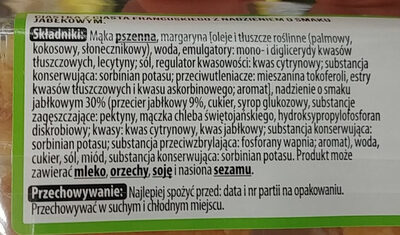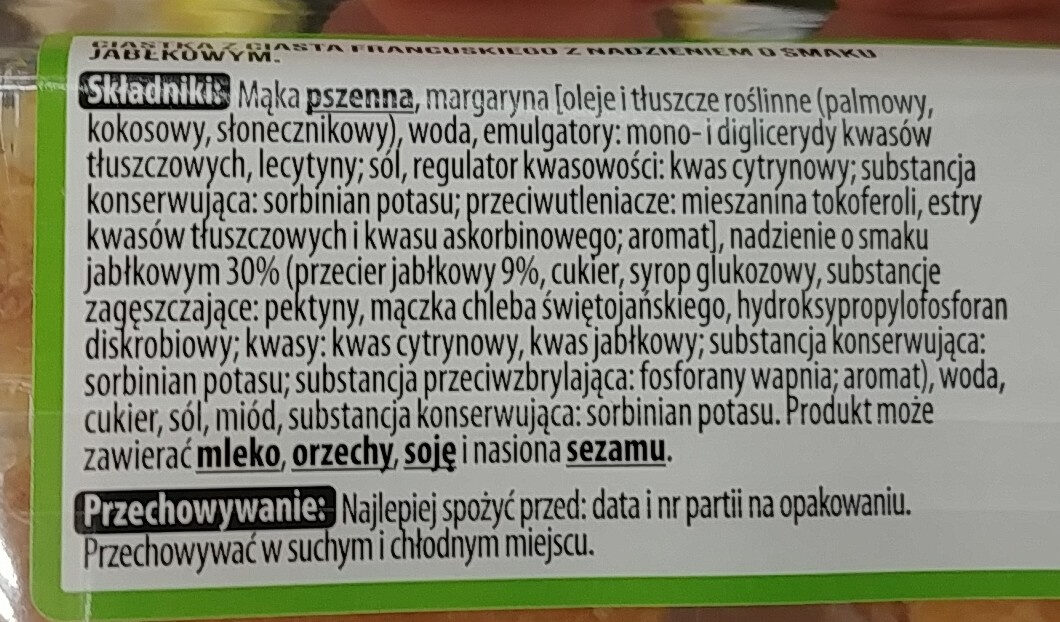Help us make food transparency the norm!
As a non-profit organization, we depend on your donations to continue informing consumers around the world about what they eat.
The food revolution starts with you!
Ciastka z nadzieniem o smaku jabłkowym - El Toro Rojo
Ciastka z nadzieniem o smaku jabłkowym - El Toro Rojo
This product page is not complete. You can help to complete it by editing it and adding more data from the photos we have, or by taking more photos using the app for Android or iPhone/iPad. Thank you!
×
Barcode: 8413760012374 (EAN / EAN-13)
Brands: El Toro Rojo
Categories: Snacks, Sweet snacks, Biscuits and cakes, Biscuits
Countries where sold: Poland
Matching with your preferences
Health
Ingredients
-
40 ingredients
: Mąka pszenna, margaryna [oleje i tłuszcze roślinne (palmowy, kokosowy, słonecznikowy), woda, emulgatory: mono - i diglicerydy kwasów tłuszczowych, lecytyny; sól, regulator kwasowości: kwas cytrynowy; substancja konserwująca: sorbinian potasu; przeciwutleniacze: mieszanína tokoferoli, estry kwasów tłuszczowych i kwasu askorbinowego; aromat), nadzienie o smaku jabłkowym 30% (przecier jabłkowy 9%, cukier, syrop glukozowy, substancje zagęszczające: pektyny, mączka chleba świętojańskiego, hydroksypropylofosforan diskrobiowy; kwasy: kwas cytrynowy, kwas jabłkowy; substancja konserwująca: sorbinian potasu; substancja przeciwzbrylająca: fosforany wapnia; aromat), woda, cukier, sól, miód, substancja konserwująca: Sorbinian potasu. Produkt może zawierać mleko, orzechy, soję i nasiona sezamu.Allergens: GlutenTraces: Nuts, Sesame seeds, Soybeans
Food processing
-
Ultra processed foods
Elements that indicate the product is in the 4 - Ultra processed food and drink products group:
- Additive: E1442 - Hydroxypropyl distarch phosphate
- Additive: E322 - Lecithins
- Additive: E440 - Pectins
- Additive: E471 - Mono- and diglycerides of fatty acids
- Ingredient: Emulsifier
- Ingredient: Flavouring
- Ingredient: Glucose
- Ingredient: Glucose syrup
- Ingredient: Thickener
Food products are classified into 4 groups according to their degree of processing:
- Unprocessed or minimally processed foods
- Processed culinary ingredients
- Processed foods
- Ultra processed foods
The determination of the group is based on the category of the product and on the ingredients it contains.
Additives
-
E1442 - Hydroxypropyl distarch phosphate
Hydroxypropyl distarch phosphate: Hydroxypropyl distarch phosphate -HDP- is a modified resistant starch. It is currently used as a food additive -INS number 1442-. It is approved for use in the European Union -listed as E1442-, the United States, Australia, Taiwan, and New Zealand.Source: Wikipedia
-
E202 - Potassium sorbate
Potassium sorbate (E202) is a synthetic food preservative commonly used to extend the shelf life of various food products.
It works by inhibiting the growth of molds, yeast, and some bacteria, preventing spoilage. When added to foods, it helps maintain their freshness and quality.
Some studies have shown that when combined with nitrites, potassium sorbate have genotoxic activity in vitro. However, potassium sorbate is generally recognized as safe (GRAS) by regulatory authorities.
-
E296 - Malic acid
Malic acid: Malic acid is an organic compound with the molecular formula C4H6O5. It is a dicarboxylic acid that is made by all living organisms, contributes to the pleasantly sour taste of fruits, and is used as a food additive. Malic acid has two stereoisomeric forms -L- and D-enantiomers-, though only the L-isomer exists naturally. The salts and esters of malic acid are known as malates. The malate anion is an intermediate in the citric acid cycle.Source: Wikipedia
-
E304 - Fatty acid esters of ascorbic acid
Ascorbyl palmitate: Ascorbyl palmitate is an ester formed from ascorbic acid and palmitic acid creating a fat-soluble form of vitamin C. In addition to its use as a source of vitamin C, it is also used as an antioxidant food additive -E number E304-. It is approved for use as a food additive in the EU, the U.S., Canada, Australia, and New Zealand.Ascorbyl palmitate is known to be broken down -through the digestive process- into ascorbic acid and palmitic acid -a saturated fatty acid- before being absorbed into the bloodstream. Ascorbyl palmitate is also marketed as "vitamin C ester".Source: Wikipedia
-
E322 - Lecithins
Lecithins are natural compounds commonly used in the food industry as emulsifiers and stabilizers.
Extracted from sources like soybeans and eggs, lecithins consist of phospholipids that enhance the mixing of oil and water, ensuring smooth textures in various products like chocolates, dressings, and baked goods.
They do not present any known health risks.
-
E330 - Citric acid
Citric acid is a natural organic acid found in citrus fruits such as lemons, oranges, and limes.
It is widely used in the food industry as a flavor enhancer, acidulant, and preservative due to its tart and refreshing taste.
Citric acid is safe for consumption when used in moderation and is considered a generally recognized as safe (GRAS) food additive by regulatory agencies worldwide.
-
E440 - Pectins
Pectins (E440) are natural carbohydrates, predominantly found in fruits, that act as gelling agents in the food industry, creating the desirable jelly-like texture in jams, jellies, and marmalades.
Pectins stabilize and thicken various food products, such as desserts, confectioneries, and beverages, ensuring a uniform consistency and quality.
Recognized as safe by various health authorities, pectins have been widely used without notable adverse effects when consumed in typical dietary amounts.
-
E471 - Mono- and diglycerides of fatty acids
Mono- and diglycerides of fatty acids (E471), are food additives commonly used as emulsifiers in various processed foods.
These compounds consist of glycerol molecules linked to one or two fatty acid chains, which help stabilize and blend water and oil-based ingredients. E471 enhances the texture and shelf life of products like margarine, baked goods, and ice cream, ensuring a smooth and consistent texture.
It is generally considered safe for consumption within established regulatory limits.
Ingredients analysis
-
Palm oil
Ingredients that contain palm oil: Palm oil and fat
-
Non-vegan
Non-vegan ingredients: HoneySome ingredients could not be recognized.
We need your help!
You can help us recognize more ingredients and better analyze the list of ingredients for this product and others:
- Edit this product page to correct spelling mistakes in the ingredients list, and/or to remove ingredients in other languages and sentences that are not related to the ingredients.
- Add new entries, synonyms or translations to our multilingual lists of ingredients, ingredient processing methods, and labels.
If you would like to help, join the #ingredients channel on our Slack discussion space and/or learn about ingredients analysis on our wiki. Thank you!
-
Vegetarian status unknown
Unrecognized ingredients: Margarine, pl:tłuszcze-roślinne-słonecznikowy, pl:mieszanína-tokoferoli, pl:nadzienie-o-smaku-jabłkowymSome ingredients could not be recognized.
We need your help!
You can help us recognize more ingredients and better analyze the list of ingredients for this product and others:
- Edit this product page to correct spelling mistakes in the ingredients list, and/or to remove ingredients in other languages and sentences that are not related to the ingredients.
- Add new entries, synonyms or translations to our multilingual lists of ingredients, ingredient processing methods, and labels.
If you would like to help, join the #ingredients channel on our Slack discussion space and/or learn about ingredients analysis on our wiki. Thank you!
-
Details of the analysis of the ingredients
We need your help!
Some ingredients could not be recognized.
We need your help!
You can help us recognize more ingredients and better analyze the list of ingredients for this product and others:
- Edit this product page to correct spelling mistakes in the ingredients list, and/or to remove ingredients in other languages and sentences that are not related to the ingredients.
- Add new entries, synonyms or translations to our multilingual lists of ingredients, ingredient processing methods, and labels.
If you would like to help, join the #ingredients channel on our Slack discussion space and/or learn about ingredients analysis on our wiki. Thank you!
: Mąka pszenna, margaryna, oleje i tłuszcze roślinne palmowy, tłuszcze roślinne kokosowy, tłuszcze roślinne słonecznikowy, woda, emulgatory (mono- i diglicerydy kwasów tłuszczowych), lecytyny, sól, regulator kwasowości (kwas cytrynowy), substancja konserwująca (sorbinian potasu), przeciwutleniacze (mieszanína tokoferoli), estry kwasów tłuszczowych i kwasu askorbinowego, aromat, nadzienie o smaku jabłkowym 30% (przecier jabłkowy 9%, cukier, syrop glukozowy, substancje zagęszczające (pektyny), mączka chleba świętojańskiego, hydroksypropylofosforan diskrobiowy, kwasy (kwas cytrynowy), kwas jabłkowy, substancja konserwująca (sorbinian potasu), substancja przeciwzbrylająca (fosforany wapnia), aromat), woda, cukier, sól, miód, substancja konserwująca (Sorbinian potasu)- Mąka pszenna -> en:wheat-flour - vegan: yes - vegetarian: yes - ciqual_proxy_food_code: 9410
- margaryna -> en:margarine
- oleje i tłuszcze roślinne palmowy -> en:palm-oil-and-fat - vegan: yes - vegetarian: yes - from_palm_oil: yes - ciqual_proxy_food_code: 16129
- tłuszcze roślinne kokosowy -> en:coconut-fat - vegan: yes - vegetarian: yes - from_palm_oil: no - ciqual_food_code: 16040
- tłuszcze roślinne słonecznikowy -> pl:tłuszcze-roślinne-słonecznikowy
- woda -> en:water - vegan: yes - vegetarian: yes - ciqual_food_code: 18066
- emulgatory -> en:emulsifier
- mono- i diglicerydy kwasów tłuszczowych -> en:e471 - vegan: maybe - vegetarian: maybe - from_palm_oil: maybe
- lecytyny -> en:e322 - vegan: maybe - vegetarian: maybe
- sól -> en:salt - vegan: yes - vegetarian: yes - ciqual_food_code: 11058
- regulator kwasowości -> en:acidity-regulator
- kwas cytrynowy -> en:e330 - vegan: yes - vegetarian: yes
- substancja konserwująca -> en:preservative
- sorbinian potasu -> en:e202 - vegan: yes - vegetarian: yes
- przeciwutleniacze -> en:antioxidant
- mieszanína tokoferoli -> pl:mieszanína-tokoferoli
- estry kwasów tłuszczowych i kwasu askorbinowego -> en:e304 - vegan: maybe - vegetarian: maybe - from_palm_oil: maybe
- aromat -> en:flavouring - vegan: maybe - vegetarian: maybe
- nadzienie o smaku jabłkowym -> pl:nadzienie-o-smaku-jabłkowym - percent: 30
- przecier jabłkowy -> en:apple-puree - vegan: maybe - vegetarian: maybe - ciqual_food_code: 13050 - percent: 9
- cukier -> en:sugar - vegan: yes - vegetarian: yes - ciqual_proxy_food_code: 31016
- syrop glukozowy -> en:glucose-syrup - vegan: yes - vegetarian: yes - ciqual_proxy_food_code: 31016
- substancje zagęszczające -> en:thickener
- pektyny -> en:e440a - vegan: yes - vegetarian: yes
- mączka chleba świętojańskiego -> en:carob-seed-flour - vegan: yes - vegetarian: yes - ciqual_proxy_food_code: 9410
- hydroksypropylofosforan diskrobiowy -> en:e1442 - vegan: yes - vegetarian: yes
- kwasy -> en:acid
- kwas cytrynowy -> en:e330 - vegan: yes - vegetarian: yes
- kwas jabłkowy -> en:e296 - vegan: yes - vegetarian: yes
- substancja konserwująca -> en:preservative
- sorbinian potasu -> en:e202 - vegan: yes - vegetarian: yes
- substancja przeciwzbrylająca -> en:anti-caking-agent
- fosforany wapnia -> en:e341 - vegan: yes - vegetarian: yes
- aromat -> en:flavouring - vegan: maybe - vegetarian: maybe
- woda -> en:water - vegan: yes - vegetarian: yes - ciqual_food_code: 18066
- cukier -> en:sugar - vegan: yes - vegetarian: yes - ciqual_proxy_food_code: 31016
- sól -> en:salt - vegan: yes - vegetarian: yes - ciqual_food_code: 11058
- miód -> en:honey - vegan: no - vegetarian: yes - ciqual_food_code: 31008
- substancja konserwująca -> en:preservative
- Sorbinian potasu -> en:e202 - vegan: yes - vegetarian: yes
Nutrition
-
Missing data to compute the Nutri-Score
Missing nutrition facts
⚠ ️The nutrition facts of the product must be specified in order to compute the Nutri-Score.Could you add the information needed to compute the Nutri-Score? Add nutrition facts
-
Nutrition facts
Nutrition facts As sold
for 100 g / 100 mlCompared to: Biscuits Fat ? Saturated fat ? Carbohydrates ? Sugars ? Fiber ? Proteins ? Salt ? Fruits‚ vegetables‚ nuts and rapeseed‚ walnut and olive oils (estimate from ingredients list analysis) 9 %
Environment
-
Eco-Score D - High environmental impact
⚠ ️Select a country in order to include the full impact of transportation.The Eco-Score is an experimental score that summarizes the environmental impacts of food products.→ The Eco-Score was initially developped for France and it is being extended to other European countries. The Eco-Score formula is subject to change as it is regularly improved to make it more precise and better suited to each country.Life cycle analysis
-
Average impact of products of the same category: B (Score: 69/100)
Category: Biscuit (cookie)
Category: Biscuit (cookie)
- PEF environmental score: 0.35 (the lower the score, the lower the impact)
- including impact on climate change: 2.88 kg CO2 eq/kg of product
Stage Impact Agriculture
80.5 %Processing
11.8 %Packaging
3.1 %Transportation
3.2 %Distribution
1.4 %Consumption
0.0 %
Bonuses and maluses
-
Missing origins of ingredients information
Malus: -5
⚠ ️ The origins of the ingredients of this product are not indicated.
If they are indicated on the packaging, you can modify the product sheet and add them.
If you are the manufacturer of this product, you can send us the information with our free platform for producers.
-
Ingredients that threatens species
Malus: -10
Contains palm oil
Tropical forests in Asia, Africa and Latin America are destroyed to create and expand oil palm tree plantations. The deforestation contributes to climate change, and it endangers species such as the orangutan, the pigmy elephant and the Sumatran rhino.
-
Missing packaging information for this product
Malus: -15
⚠ ️ The information about the packaging of this product is not filled in.⚠ ️ For a more precise calculation of the Eco-Score, you can modify the product page and add them.
If you are the manufacturer of this product, you can send us the information with our free platform for producers.
Eco-Score for this product
-
Impact for this product: D (Score: 39/100)
Product: Ciastka z nadzieniem o smaku jabłkowym - El Toro Rojo
Life cycle analysis score: 69
Sum of bonuses and maluses: -30
Final score: 39/100
-
Carbon footprint
-
Equal to driving 1.5 km in a petrol car
288 g CO² per 100g of product
The carbon emission figure comes from ADEME's Agribalyse database, for the category: Biscuit (cookie) (Source: ADEME Agribalyse Database)
Stage Impact Agriculture
82.9 %Processing
7.9 %Packaging
3.8 %Transportation
4.7 %Distribution
0.7 %Consumption
0.0 %
Packaging
-
Missing packaging information for this product
⚠ ️ The information about the packaging of this product is not filled in.Take a photo of the recycling information Take a photo of the recycling information
Transportation
-
Origins of ingredients
Missing origins of ingredients information
⚠ ️ The origins of the ingredients of this product are not indicated.
If they are indicated on the packaging, you can modify the product sheet and add them.
If you are the manufacturer of this product, you can send us the information with our free platform for producers.Add the origins of ingredients for this product Add the origins of ingredients for this product
Threatened species
-
Contains palm oil
Drives deforestation and threatens species such as the orangutan
Tropical forests in Asia, Africa and Latin America are destroyed to create and expand oil palm tree plantations. The deforestation contributes to climate change, and it endangers species such as the orangutan, the pigmy elephant and the Sumatran rhino.
Report a problem
-
Incomplete or incorrect information?
Category, labels, ingredients, allergens, nutritional information, photos etc.
If the information does not match the information on the packaging, please complete or correct it. Open Food Facts is a collaborative database, and every contribution is useful for all.
Data sources
Product added on by pyrka
Last edit of product page on by arc2.
Product page also edited by foodvisor, openfoodfacts-contributors, roboto-app, sierigh.








